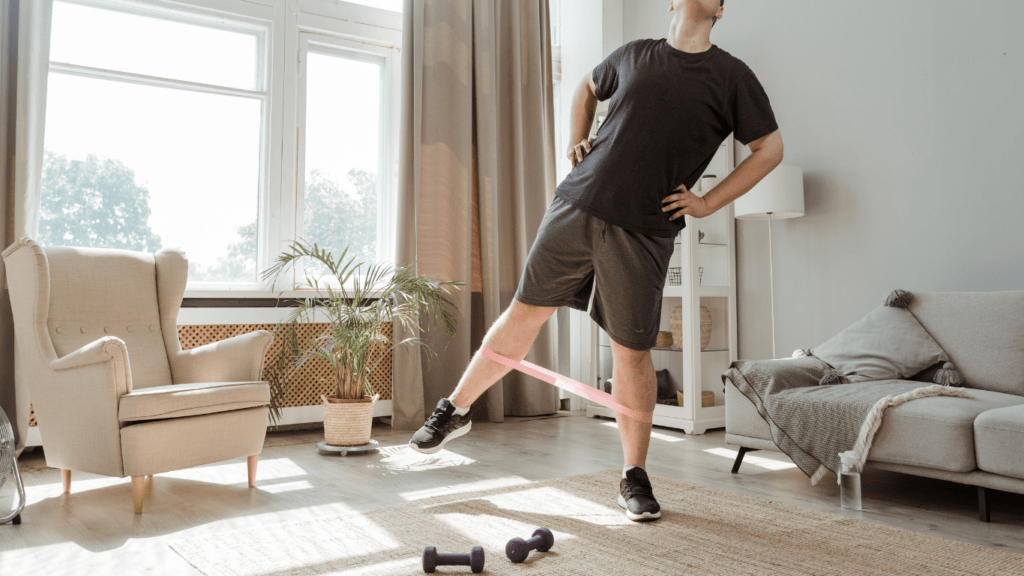Understanding Resistance Bands
Resistance bands are a crucial component in enhancing fitness routines. They are known for their versatility, allowing for a wide range of exercises and adaptability to different fitness levels.
Types of Resistance Bands
Resistance bands come in various forms, each offering unique features:
- Loop Bands: Often used for lower body exercises, loop bands are circular and fit snugly around ankles or thighs.
- Therapy Bands: Flat and stretchable, therapy bands suit rehabilitation exercises and are commonly used in physical therapy.
- Tube Bands: Equipped with handles, tube bands provide a good grip for upper body workouts and can replicate the feel of free weights.
- Figure-8 Bands: Shaped like the number eight, these bands target the upper body with a focus on biceps and triceps.
Benefits of Using Resistance Bands
Resistance bands offer several advantages for workout enthusiasts:
- Portability: Lightweight and compact, resistance bands can be easily carried for workouts anywhere.
- Versatility: They enhance various exercises by adding different resistance levels, from light to heavy.
- Cost-Effective: As an affordable alternative to gym equipment, resistance bands cater to budget-conscious individuals.
- Injury Prevention: Offering controlled resistance, bands reduce the risk of injury compared to heavier weights.
By understanding and utilizing these various types of resistance bands, anyone can effectively incorporate them into their workouts, benefiting from their unique features and advantages.
Getting Started with Resistance Bands
Resistance bands add a new dimension to any fitness routine. They’re easy to use and fit into almost any workout plan.
Choosing the Right Resistance Band
- Resistance bands come in various shapes, sizes, and resistance levels.
- First, consider the type of exercise and muscle groups you’ll target. For lower body exercises, loop bands offer greater stability.
- Tube bands, with handles, are excellent for upper body workouts.
- For rehabilitation, therapy bands provide ample flexibility.
- When choosing resistance levels, start with a medium band and adjust based on the exercise difficulty and your fitness level.
- Brands often color-code bands by resistance; refer to the manufacturer’s chart for guidance.
Setting Up Your Space
For effective workouts, a simple setup is key. Begin by clearing a space at least 6 feet by 6 feet. Ensure surfaces are even to prevent tripping or slipping during exercises. Use an exercise mat for floor-based routines to enhance comfort. Secure an anchor point, such as a closed door or sturdy railing, when using tube bands to expand exercise possibilities. With a dedicated space, transitions between exercises become smoother, maximizing workout sessions with minimal interruptions.
Incorporating Resistance Bands into Your Routine

Incorporating resistance bands into workouts expands exercise options and enhances physical performance. I’ll guide you through using these tools effectively for various muscle groups.
Lower Body Exercises
Lower body exercises boost strength and mobility. I integrate resistance bands with squats and lunges by placing a loop band around my thighs. This approach adds targeted resistance and emphasizes muscle engagement. Glute bridges also benefit from resistance bands. I position a band above my knees, press against it, and effectively activate glutes and hamstrings.
Upper Body Exercises
For upper body workouts, resistance bands replace traditional weights while still delivering intense results. I perform seated rows with tube bands, anchoring them at door height for maximal engagement of my back and shoulders. Bicep curls using figure-8 bands focus on isolating the biceps while maintaining controlled movements. I adjust my grip on the bands to vary the intensity.
Core Exercises
Core exercises improve stability and core strength. I incorporate resistance bands in Russian twists by sitting on the floor and wrapping the band around my feet. Holding the band’s ends, I twist my torso side-to-side. This enhances oblique and abdominal engagement. For mountain climbers, I loop a band around my feet to increase resistance and overall intensity.
Tips for Maximizing Your Workout
Incorporating resistance bands into workouts effectively maximizes results. To achieve this, proper form and a progressive approach are essential.
Proper Form and Technique
Maintaining correct form prevents injuries and ensures effectiveness. When using resistance bands, keeping a neutral spine and engaging the core is crucial. For exercises like squats, aligning knees with toes and avoiding excessive forward lean optimizes performance. During upper body routines, such as chest presses and rows, focusing on scapular retraction and controlling the band’s tension enhances muscle engagement. Consistent breathing and slow, controlled movements improve balance and reduce strain.
Progression and Consistency
Gradual progression boosts strength and endurance. Starting with a medium-resistance band for most exercises allows adaptation to new challenges. Increasing resistance or repetitions as the body adjusts prevents plateaus. It’s the dedication to a regular workout schedule that builds lasting results over time. Integrating resistance bands into a weekly routine, ideally 3-4 sessions, maintains consistency and supports goal achievement. Embracing these practices transforms the workout experience, offering variety and tangible progress.

 Kirstiella Wagnerson’s expertise in sports psychology has been a cornerstone of Make Athlete Action, where she has contributed valuable insights into the mental aspects of athletic performance. Her knowledge of motivation, focus, and mental resilience empowers athletes to overcome challenges and reach their goals. Kirstiella’s engaging content on mental toughness and motivation offers readers practical strategies to boost their mindset, helping them stay motivated and focused. Her dedication to the psychological well-being of athletes has made Make Athlete Action a comprehensive platform for both physical and mental fitness.
Kirstiella Wagnerson’s expertise in sports psychology has been a cornerstone of Make Athlete Action, where she has contributed valuable insights into the mental aspects of athletic performance. Her knowledge of motivation, focus, and mental resilience empowers athletes to overcome challenges and reach their goals. Kirstiella’s engaging content on mental toughness and motivation offers readers practical strategies to boost their mindset, helping them stay motivated and focused. Her dedication to the psychological well-being of athletes has made Make Athlete Action a comprehensive platform for both physical and mental fitness.